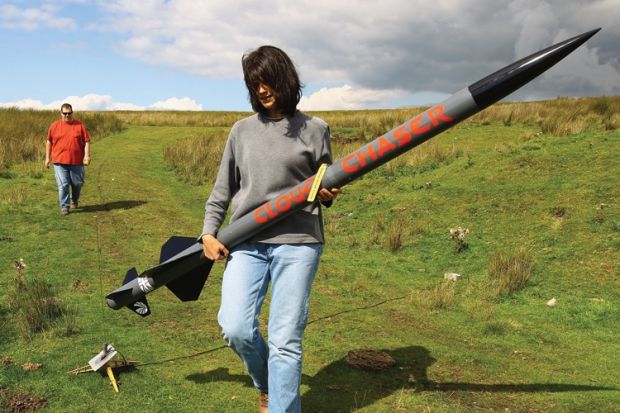Source: Getty
Accelerator: the Equality Challenge Unit’s Charter for Women in Science is set to take on a far greater role in boosting gender equality in a number of fields
The mention of Athena SWAN at this year’s Conservative Party conference is a timely indicator of how far the once-tiny gender equity charter scheme has come and its growing influence within academia.
Having announced £200 million of new capital funding for teaching science, technology, engineering and mathematics subjects, David Willetts, the universities and science minister, said he expected to see “evidence of commitment to equality and diversity” furnished by those making bids for the cash.
“Some version of Athena SWAN” showing institutional strategies for achieving gender equity in STEM departments “will focus minds”, Mr Willetts added.
His decision to make millions of pounds of investment contingent on measures similar to the Equality Challenge Unit-run initiative - indeed, it may well be Athena SWAN itself - highlights the considerable clout it now wields.
It is just the latest milestone for a programme whose growth - in members, disciplines, influence and acceptance within the sector - in less than a decade has been remarkable.
When it was launched at the Institute of Physics in June 2005, it involved just 10 universities, and its focus was increasing the number of women in STEM departments.
This month, the University of Chester became its 93rd member, while 87 awards were made to individual departments and institutions in the latest of its biannual awards round alone.
The initiative - officially named the Athena SWAN Charter for Women in Science - is also expanding to cover the arts, humanities and social sciences, it was announced in July.
A trial of the new charter, which will run in parallel with the STEM scheme, will take place at up to 30 institutions until spring 2014 - with the arts and science schemes likely to combine to form a single institutional award in future.
This year has also seen the launch of a race charter mark to help tackle racial discrimination in the academy.
‘Quasi-regulatory’ role evolves
These developments suggest a far greater role for Athena SWAN in coming years, but it was the decision in 2011 to link it to Department of Health research funding that put a rocket booster under the programme.
Under guidance issued by Dame Sally Davies, the chief medical officer, from 2015 medical schools may no longer be shortlisted for research funding unless they have a silver award. The move saw applications to Athena SWAN treble between 2012 and 2013.
Dame Sally’s letter also changed the nature of the charter mark, making it less of a voluntary opt-in for institutions and giving it a “quasi- regulatory flavour”, admits David Ruebain, the ECU chief executive.
With high stakes now riding on Athena SWAN’s judgements, its decisions and processes are likely to come under far greater scrutiny. “We have reviewed our processes as we need to make sure they are demonstrably fair and transparent,” Ruebain says.
Given that Athena SWAN could face potential legal challenges by institutions that fail to gain awards, Ruebain, who spent 22 years as a practising solicitor, says he may also consider indemnity insurance similar to that taken out by the Quality Assurance Agency to guard itself against incurring massive legal fees in the event of legal action.
“It is a risk, so we may make ameliorative steps and that may include insurance,” he indicates.
However, he believes that Athena SWAN’s decision-making process - using panels of volunteer scientists assessing up to eight applications a day - is robust enough to withstand the new pressures placed on it.
“We do not simply rubber-stamp any application,” he says, pointing out that many departments’ bids are rejected on each round.
If other research councils, which publicly support Athena SWAN, were also to make its charter mark a requirement of funding, then the pressure on the organisation would be even greater.
But this is unlikely to happen because research councils do not face the same pressures as the NHS to address gender inequality, says David Palfreyman, director of the Oxford Centre for Higher Education Policy Studies and co-author of The Law of Higher Education.
“Research councils may not follow the NHS since [there] may [be] less formally expected of them - in terms of being proactive [in tackling inequalities] - under the Equality Act 2010, but, on the other hand, research council officials may get carried away,” he says.
Good ideas come at a price
The cost implications of implementing Athena SWAN further across the sector should also be considered, adds Palfreyman.
“What seemed like a laudable and good idea can become a bureaucratic and costly straitjacket,” he says. “Often bureaucrats gold-plate the spirit of the legislation, creating a few hundred administrative jobs along the way and using up a few million pounds of taxpayers’ money.”
Beefing up the Athena SWAN system, which is currently subsidised by several quangos and public bodies, and dealing with a flood of applications may also require a rise in the £1,000 annual membership fee, set to be reviewed this year.
Questions might also be asked about the lack of transparency over panel decisions, which are issued simply as a list, with no publicly available data on how awards or renewals were made.
Louise Morley, director of the Centre for Higher Education and Equity Research at the University of Sussex, believes too great a focus on Athena SWAN could obscure other equally important problems slowing the achievement of gender equality in the academy.
“It places all the responsibility on higher education institutions when we also need to review related organisations such as funding councils, publishers and journals, because these contribute to creating or impeding opportunity structures for women,” argues Morley.
Athena SWAN’s focus on academic work-life balance also tacitly assumes a lack of institutional sexism within higher education, she adds.
“It suggests the major barrier for women’s academic careers is childcare,” Morley adds.
“While this is an important consideration, it does not account for why women who are child-free or whose children have grown up are still not flourishing in the academy.”
Nonetheless, the scheme is likely to be vital in tackling gender discrimination in the academy, particularly by forcing institutions to scrutinise their decision-making on the recruitment, selection and promotion of women.
If other research councils were to follow the example of the National Institute for Health Research with regard to Athena SWAN, then significant sector-wide progress could be made.
“As [research] funding regimes tend to structure priorities in higher education, Athena SWAN could be a major catalyst for change,” she says.
Register to continue
Why register?
- Registration is free and only takes a moment
- Once registered, you can read 3 articles a month
- Sign up for our newsletter
Subscribe
Or subscribe for unlimited access to:
- Unlimited access to news, views, insights & reviews
- Digital editions
- Digital access to THE’s university and college rankings analysis
Already registered or a current subscriber? Login




